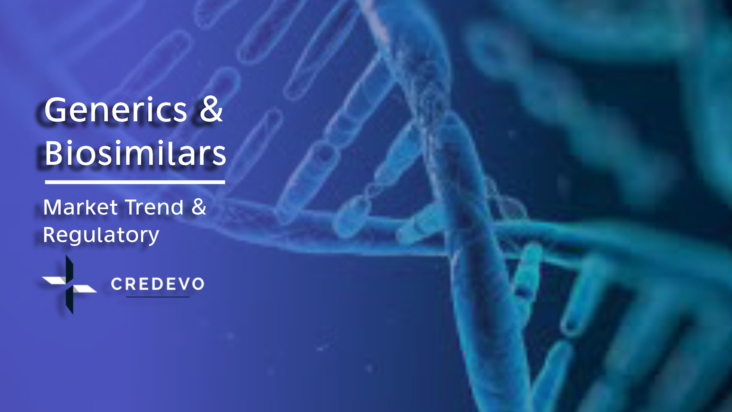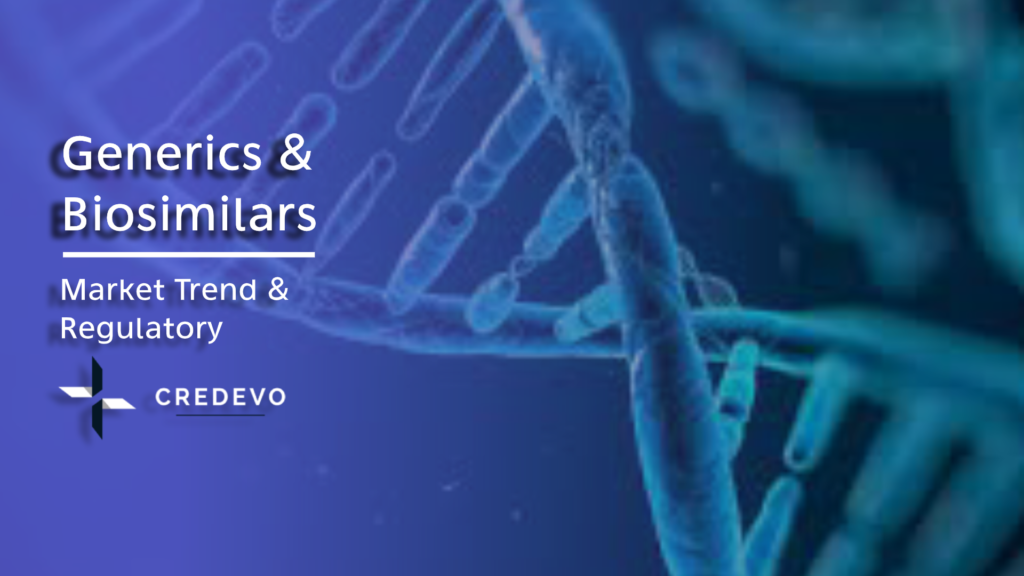Generics & Biosimilars: Market Trend & Regulatory

In 2019, the global generic drugs market reached a value of US$ 367 Billion. with a CAGR of 5.7% during the period 2014-2019. The US generic drug market is foreseen to reach US$ 208.6 Billion by 2025, with a projected CAGR of 10.46% during 2020-2025, according to a report by IMARC Group,

The global biosimilars market, which was valued at $5.5 billion in 2018, is estimated to grow at a CAGR of 38.21% during the forecast period of 2019 to 2025. Europe is currently the most lucrative region for the biosimilars market and accounted for approximately 74% of the global market share and the market is gaining traction in the North American region at a rapid pace.
Biosimilar medication was developed for many diseases including chronic diseases like cancer, cardiovascular disease, etc. The oncology disease segment is the key to the biosimilars market.
The oncology disease application in the biosimilars market is growing at a CAGR of 41.58% through the forecast period. Another therapeutic segment like autoimmune diseases as inflammatory bowel disease, psoriasis, and arthritis is gaining traction.
Why are companies looking for generic and biosimilar market?
increasing prevalence of chronic diseases like diabetes & cardiovascular diseases, large geriatric population, increasing healthcare expenditure contributes to the growth of the generic drug market along with an increased number of branded drug patent expiries.
Some of the other key factors include
- Stringent governmental regulations and adverse effects associated with new drug development.
- The rising demand for newer versions of generic drugs
- A large number of licensing & procedural strategies to launch new products by companies
- Compared with branded drugs, the production of generic drugs cost much less as they don’t require the repetition of animal studies and clinical trials to demonstrate the safety and efficacy of the medicine.
- Due to the reduced upfront cost incurred in research, generics are typically sold at a substantially lower price in the market.
Classification of market
On the basis of product type, the market can be classified into
- Simple generics,
- Super generics, and
- Biosimilars.
Based on the application of the market, the divided into
- Cardiovascular products,
- Anti-infective drugs,
- Anti-arthritis drugs,
- Central nervous system drugs,
- Anti-cancer drugs, respiratory products, etc.
On the basis of the distribution channel, the market is segmented into
- Hospitals,
- Pharmacies,
- Private clinics,
- Drug stores,
- Retail pharmacies, etc.
What are generics?
A generic drug is a medicine that contains the same active ingredient and has an equivalent therapeutic effect as the branded drug. These drugs are also identical in terms of safety, quality, dosage, strength, route of administration, intended use, effect, form, quality and side effects, These drugs can be produced only after the patent expiration of the brand-name drug.
These are simple in chemical structure and can be manufactured easily compared to biosimilars.
What are biosimilar drugs?
A biosimilar is a biologic medical product that is highly similar to already approved biological medicine. These biosimilars are approved according to the same standards of pharmaceutical quality, safety, and efficacy which apply to all biological medicines.
Similar to generics, biosimilars products cannot be manufactured until the original patent of the product expires, however, a biosimilar is not regarded as a generic of a biological medicine because the natural variability and more complex manufacturing of biological medicines do not allow an exact replication of the molecular micro-heterogeneity.
Difference between biologics and generics products
Though both biosimilars and generic drugs have the same commercial goals and are only allowed to market when the patent of the original drug has expired, they are two completely different products when it comes to their structure, development, and authorization.
Here are some main differences between biosimilars and generic drugs.
- Biologic medicines are large and complex molecules or mixtures of molecules that may be composed of living material while generic medicines are chemically synthesized
- Unlike generic drugs, the FDA requires a biosimilar to be highly similar, but not identical to the existing biologic medicine, or the reference product
- A biosimilar medicine must demonstrate no clinically meaningful differences in efficacy, safety, and potency with its reference product and must be highly similar to the original biological drug, while the generics are as the branded products
- The cost of the generic drugs generally stands at 40 percent to 50 percent less than the branded products and biosimilars and in contrast, is closer to 15 percent to 20 percent cheaper due to the amount the drug manufacturer spent on testing.
- For generics it is easy to produce exact copies of branded drugs and requires no complex modifications, makes the manufacturing process easy and predictable.
- Biosimilars and reference drugs are not synthesized through a simple chemical synthetic reaction like generic drugs and require a complex process in a cellular environment like any protein from the body.
- Approximately, generic drugs require an investment of around 2-3 million dollars for their development and due to the complexity involved, biosimilars require an investment of around 3 billion dollars.
- Generic drugs can reach the market in a period of 2 to 3 years, but a biosimilar drug needs approximately between 7 and 8 years in order to reach the market. This long timeline for biosimilars is due to the numerous studies necessary for their authorization, which include safety and efficacy studies in comparison with reference branded drugs.
- Generic drugs require bioequivalence studies in healthy volunteers but don’t require preclinical studies and once marketed require a standard pharmacovigilance process,
- Unlike generics, biosimilars are reviewed and approved under the abbreviated FDA review process known as the 351(k) pathway 2
General requirements to market generic products
For getting market access and approval, generic manufacturers shall provide some regulatory requirements which most of the regulators look for. Here are some of them
- Data showing the quality of active and inactive ingredients in the manufacturing process is critical for any generic product to market. These data show the regulatory that the manufacture can produce a reliably high-quality product.
- The second important data is to show that the product is similar to the branded drug in terms of outcomes and results in treating patients. To prove this company is required to conduct trials with human volunteers who take both the brand and generic drug products. This data is compared and validated by regulators that the product is safe and effective and can be used as a substitute for the branded products.
- Companies need to prove the stability of the product and will not deteriorate over time, and the manufacturer can produce the same drug every time.
- Manufacturers shall make sure that their facilities are in good standing with the FDA.
General requirements to market biosimilars products
- Approval of biosimilars is based on clinical evidence, ideally from comparative clinical trials with target patients, demonstrating an equally similar level of clinical benefit and safety compared to their reference biologics.
- To ensure that biosimilars do not cause any severe immune reactions, specific testing is needed in patients during the development of biosimilars.
- Each biosimilar medicine should be clearly identified with a unique brand name, international non-proprietary name (INN), and batch number which allows patients and health professionals to clearly know exactly which medicine they are receiving and will be increasingly important as more than one biosimilar is developed to the same reference biologic.
Regulatory for biosimilars
Drug-related authorities such as the EU’s European Medicines Agency (EMA), the US’s Food and Drug Administration (FDA), and the Health Products and Food Branch of Health Canada hold their own guidance on requirements for demonstration of the similar nature of two biological products in terms of safety and efficacy.
EUROPE
- Europe was the first region in the world to develop a legal, regulatory, and scientific framework for approving biosimilar medicines has granted marketing authorization for more than 50 biosimilars since 2006 through EMA
- In comparison to the original branded biologic, a biosimilar undergoes an accelerated approval process, as it may require fewer data to meet the established regulations.
- Approval of medicines in the EU relies on a solid legal framework, established in 2004. From then the EU has approved the highest number of biosimilars worldwide and consequently has the most extensive experience.
- European Medicines Agency (EMA) regulations for biosimilars require these biologic copies to undergo extensive analytical chemistry, manufacturing, and control (CMC) and clinical processes to prove similarity to the reference product.
- All medicines produced using biotechnology and those for specific indications such as for cancer, neurodegeneration, and auto-immune diseases must be approved in the EU through the EMA Centralised procedure.
- When a company applies for marketing authorization at EMA, data is evaluated by EMA’s scientific committees on human medicines and on safety (the CHMP and PRAC), as well as by EU experts on biological medicines (Biologics Working Party) and specialists in biosimilars (Biosimilar Working Party)
- The review by EMA results in a scientific opinion, which is then sent to the European Commission, which ultimately grants an EU-wide marketing authorization.
United States
- The current U.S. Food and Drug Association (FDA) regulations for biosimilars require these biologic copies to undergo extensive analytical chemistry, manufacturing, and control (CMC) and clinical processes to prove similarity to the reference product.
- However, in comparison to the originator biologic, a biosimilar could see an accelerated approval process, as it might need fewer data to meet the established regulations.
- In 2012, the FDA released three draft guidances to assist biosimilar developers in demonstrating their product’s bio-similarity.
- To comply with existing U.S. regulations, manufacturers are expected to include structural analysis, functional assays, and data from animal and human clinical trials in their applications. As biosimilar production spreads globally, regulations have continued to shift and evolve.
Regulatory for generics
- Due to an aging population and increasing incidences of chronic diseases, governments of developed countries have been making efforts to reduce healthcare costs by promoting the production of generics and in developing countries, affordability and accessibility are some of the primary issues faced by the healthcare industry.
- Health care professionals and scientists with a wide range of expertise work together to make sure that every generic drug is safe, effective, high quality, and substitutable to the brand name drug.
- To address these problems, governments and other regulatory bodies have been encouraging manufacturers to introduce effective generic drugs. However, despite the rapid patent expiry of branded drugs, there has been a shortage of generics.
- Submission of a complete application with all the information required to show the generic drug is safe, effective, high quality, and substitutable to the branded drug makes the approval process easier.
- The timeline for approval depends on the complexity of the drug product and the completeness of the application.
- Once a generic drug is approved, manufacturers shall report any problems and serious adverse health effects to the regulators for evaluation.
- Regulators will periodically inspect manufacturing plants to monitor drug quality and evaluate any proposed changes to the generic drug product after its approval.
- Significant changes require review and approval by the FDA before the changed generic drug is released to patients.
Key market players
The key players that operate in this market include Abbott Laboratories, Teva Pharmaceutical Industries Ltd., ALLERGAN, Sandoz International GmbH, Mylan N.V., STADA Arzneimittel AG, Baxter International Inc., Eli Lilly and Company, GlaxoSmithKline Plc., and Pfizer Inc.
Are you looking for regulatory support for your generic or biosimilar medicinal products?
Talk to us today. Provide details of your requirements and we will connect with you.
References
- https://www.imarcgroup.com/generic-drug-manufacturing-plant
- https://www.alliedmarketresearch.com/generic-drugs-market
- https://en.wikipedia.org/wiki/Biosimilar
- https://www.imarcgroup.com/us-generics-market
- https://www.mabxience.com/blogs/differences-between-biosimilars-and-generic-drugs/
- https://www.biosimilardevelopment.com/doc/about-biosimilar-regulations-0001
- https://www.cancercenter.com/community/blog/2018/12/whats-the-difference-biosimilar-and-generic-drugs
- https://www.examinebiosimilars.com/biosimilars-vs-generics.html